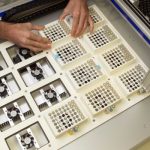Keep it steamy: improved quantification of the humidity within the leaf
Magdalena M. Julkowska
Stomata are the gatekeepers of plant water status, regulating the balance between plant CO2 uptake and water loss. Stomatal conductance (gs) can be estimated by microscopy of wax or plastic leaf surface imprints, but this technique is time consuming and labor intensive. Another method for assessment of gs relies on measurements of (1) leaf water loss, (2) air humidity surrounding the leaf and (3) leaf temperature. Typically, the responsiveness of the stomatal aperture is tested by gradually decreasing atmospheric water pressure surrounding the leaf (i.e., increasing the Vapor-Pressure Deficit, VPD) and recording the corresponding transpiration response. Assuming that the air inside the leaf is saturated, the humidity within the leaf can be calculated from the leaf temperature. This assumption can be tested using a recently developed method, where leaf gas exchange is coupled with measurements of the stable isotope compositions of CO2 and water vapor passing over the leaf, both of which become enriched in 18O during transpiration (Cernusak et al., 2018). Using this method, it was observed that the intercellular vapor pressure dropped below saturation when the leaves of two conifer species were exposed to increasing VPD (Cernusak et al., 2018), challenging the assumption that leaf vapor pressure is always saturated.
In the work published in this issue of Plant Physiology, Cernusak (et al., 2019) used the stable-isotope method to examine the changes in gs and intercellular vapor pressure in the leaves of wild-type poplar and the abi1 mutant, which exhibits compromised stomatal closure. They observed that in the WT plants, stomatal conductance and photosynthesis rate decreased with the increasing VPD, while the relative humidity inside the leaf was maintained. In the abi1 mutants, the humidity inside the leaf decreased with increasing VPD. This lower intercellular humidity in abi1 mutants had tremendous consequences, as no gas exchange could be observed above 2.5 kPA VPD, which corresponded to the drop of relative humidity inside the leaf below 60%. The results presented by Cernusak et al., demonstrate perfectly the essential role of stomata by illustrating the precision with which they function to maintain a moisture-saturated leaf interior, and contrasts this with the narrow survival envelope of a mutant with impaired ABA signaling. The new method where gas exchange is combined with stable isotope measurements provides an improved estimation of gs and internal leaf humidity. The method also allows quantification of the importance of functional stomata, preventing the drop in relative humidity with increasing VPD.
Another paper in this issue of Plant Physiology (Holloway-Phillips et al., 2019) takes a two-source d18O technique one step further, using source gasses of two different isotopic compositions, allowing simultaneous estimation of mesophyll conductance and intercellular humidity. While the methods described by Holloway-Phillips (et al. 2019) and Cernusak (et al., 2018) both allow addressing questions that were out of reach thus far, they require highly specialized equipment, careful calibration, and extensive expertise. However, as the technology continues to develop, the possibilities of scaling the simultaneous measurement of intercellular humidity and mesophyll conductance in a wider range of species will improve. Cernusak et al. already observed that the range of internal leaf humidity differed between poplar (Cernusak et al., 2019) and coniferous species tested in earlier studies (Cernusak et al., 2018). The stomata of vascular plants show wide diversity, from kidney-shaped guard cells in Arabidopsis to dumbbell-shaped stomata in the grasses, with the stomatal size and density differing across the species, accessions and growth conditions (Harrison et al., 2019). Future studies using the improved method for quantification of intercellular humidity and mesophyll conductance will be able to show how these morphological and developmental differences in stomata affect humidity within the leaf, transpiration and the photosynthetic rate.
LITERATURE CITED
Cernusak LA, Goldsmith G, Arend M, Siegwolf RTW (2019) Effect of vapor pressure deficit on gas exchange in wild-type and abscisic acid-insensitive plants. Plant Physiol. doi: https://doi.org/10.1104/pp.19.00436
Cernusak LA, Ubierna N, Jenkins MW, Garrity SR, Rahn T, Powers HH, Hanson DT, Sevanto S, Wong SC, McDowell NG, et al (2018) Unsaturation of vapour pressure inside leaves of two conifer species. Sci Rep 8: 7667
Harrison EL, Arce Cubas L, Gray JE, Hepworth C (2019) The influence of stomatal morphology and distribution on photosynthetic gas exchange. Plant J. doi: 10.1111/tpj.14560
Holloway-Phillips M-M, Cernusak LA, Stuart-Williams H, Ubierna N, Farquhar GD (2019) Two-source δ18O method to validate the CO18O-photosynthetic discrimination model: implications for gm. Plant Physiol. https://doi.org/10.1104/pp.19.00633




